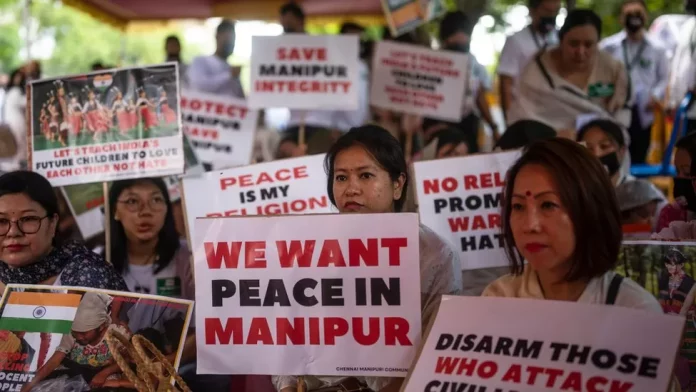Manipur is currently facing a grave situation of ethnic violence, which some are describing as a state of civil war. The conflict involves the two major groups in the region: the Meitei, who constitute the majority, and the Kuki, who are a minority. The main issues driving the violence are disputes over land and influence. Here is the complete guide of Manipur violence case study.
A disturbing video recently came to light, showing an incident that occurred in May. In the video, Meitei men are seen attacking two Kuki women, parading them naked after their village had been destroyed. This incident is the latest in a series of acts of terror targeting women in the area.
Table of Contents
What is happening in Manipur?
Since May, a tragic wave of violence has resulted in the deaths of over 130 people and left around 400 others injured. The escalating conflict has also led to a staggering displacement of over 60,000 individuals, as authorities, including the army, paramilitary forces, and police, strive to bring the violence under control.
During the unrest, police armouries were targeted and looted, resulting in a significant proliferation of weapons. Additionally, the violence has taken a toll on religious institutions, with hundreds of churches and over a dozen temples being destroyed in the affected region, further exacerbating the already dire situation. Numerous villages have also been ravaged and reduced to ruins amidst the ongoing turmoil.
How did it start??
Tensions reached a boiling point when the Kukis initiated protests against the Meiteis’ demands to obtain official tribal status. The Kukis contended that granting this status would further augment the Meiteis’ already significant influence on the government and society, potentially enabling them to acquire land or settle in predominantly Kuki areas.
However, the reasons behind the unrest are complex and multifaceted. The Kukis assert that the Meitei-led government’s supposed war on drugs is merely a pretext to displace their communities, leading to further discontent.
Adding to the strain is the issue of illegal migration from Myanmar, which has heightened existing tensions in the region. The pressure on land use due to a growing population has also contributed to the escalation of conflicts. Furthermore, the problem of unemployment has driven many young individuals towards joining various militias, exacerbating the overall situation.
Who is fighting whom?
For several decades, Meitei, Kuki, and Naga militias have been engaged in conflicts, primarily driven by conflicting homeland demands and religious differences. These groups have also clashed with India’s security forces during this period. However, the most recent escalation of hostilities is predominantly centered between the Meitei and the Kuki communities.
Dhiren A Sadokpam, the editor of The Frontier Manipur, highlights that this time, the conflict is solely based on ethnic differences, rather than religious factors.
Who are these communities?
The Meitei community has historical connections to Manipur, Myanmar, and the nearby regions. While the majority of Meiteis practice Hinduism, there are also some followers of the Sanamahi religion. On the other hand, the Kuki community, primarily Christian, has expanded across various northeastern states of India, with many of them tracing their origins back to Myanmar as well.
Geographically, the Meiteis predominantly reside in the Imphal valley, while the Kukis live in the surrounding hills and beyond.
Causes Behind Attacks and Humiliation of Women in the Conflict Zone
According to local media, the attack in May came after fake reports a Meitei woman had been raped by Kuki militiamen. This unleashed “a new, deadly cycle of reprisal violence on Kuki tribal women allegedly by Meitei mobs”.
Military Deployment & Evacuations
Curfew was imposed across eight districts, including non-tribal dominated Imphal West, Kakching, Thoubal, Jiribam, and Bishnupur districts, as well as tribal-dominated Churachandpur, Kangpokpi, and Tengnoupal districts.
The Manipur government issued a shoot at sight order on 4 May. By the end of 3 May, 55 columns of the Assam Rifles and the Indian Army were deployed in the region and by 4 May, more than 9,000 people were relocated to safer locations. By 5 May, about 20,000 and by 6 May, 23,000 people had been relocated to safe locations under military supervision. The central government airlifted 5 companies of the Rapid Action Force to the region. Nearly 10,000 army, para-military and Central Armed Police Forces were deployed in Manipur. On 4 May, the Union government invoked Article 355, the security provision of the Indian constitution, and took over the security situation of Manipur. As of 14 May, the total military build up in Manipur stood at 126 army columns and 62 companies of paramilitary forces.
The insertion of troops led to several engagements between hill-based militants and the Indian Reserve Battalion, resulting in at least five militant deaths. In a separate encounter, four militants were killed. By 6 May the situation had calmed down to a degree. According to journalist Moses Lianzachin, at least twenty-seven churches were destroyed or burned down during the violence. As of 9 May, according to the Manipur government, the death toll was over 60 people. The situation was described as “relatively peaceful” on 10 May, with the curfew being relaxed in places, though unknown militants fired on Indian troops in an incident in Manipur’s Imphal East district, injuring one.
On 12 May, suspected Kuki militants ambushed policemen in Bishnupur district, killed one officer and injuring five others. In a separate incident, a soldier was stabbed and three Meitei community members kidnapped in Torbung, Churachandpur district. A day later, the security advisor to the Manipur Government Kuldeep Singh raised the total fatality count from the violence to more than 70 deaths. This included the discovery of three Public Works Department labourers found dead in a vehicle in the Churachandpur from unknown causes. He added the number of internally displaced people living in camps had been significantly reduced, and that about 45,000 people had been relocated to other areas.
On 14 May, reports of fresh violence surfaced in the Torbung area, with unidentified arsonists torching more property, including houses and trucks. Five companies of Border Security Forces were deployed. In a separate incident, two Assam Rifles personnel were injured. The same day, a delegation of state ministers led by Manipur Chief Minister Biren Singh left for New Delhi to meet Union home minister Amit Shah to discuss the situation. The reported tally of casualties and property damage from the violence by this point stood at 73 dead, 243 injured, 1809 houses burned down, 46,145 people evacuated, 26,358 people taken to 178 relief camps, 3,124 people escorted evacuation flights, and 385 criminal cases registered with the authorities.
The internet blackout and curfew remained in place on 16 May. Food was also reported to be scarce, with shops, schools and offices closed, and thousands of people stranded in refugee camps. Fresh violence over the weekend had led to further displacements. On 17 May, the internet blackout was extended for five more days. Fresh violence occurred on 29 May during which at least five people including one policeman was killed.
On 26 May, the Meitei revivalist organization Arambai Tenggol announced that it was dissolving itself, citing certain “unwanted developments” that had taken place in the last few days. On 28 May, a fierce gunfight was reported between militants of surrendered Valley-based Insurgent Groups (VBIGs), now operating under the Arambai Tenggol banner, and a unit of Assam Rifles.
🔥1.9 K










